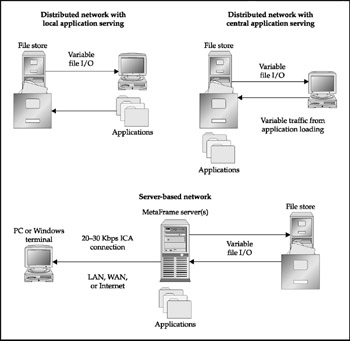Chapter 6: Designing Your Network for On-Demand Access
| | ||
| | ||
| | ||
OVERVIEW
While network design considerations for on-demand access share many common design criteria with traditional distributed fat-client networks, the on-demand access paradigm adds several unique considerations to the design process. With minimal changes, the same networks that support classic Windows-based computing environments can be optimized to support an on-demand access scenario. The goal of this chapter is to recap common design fundamentals, introduce characteristics unique to on-demand access, and provide insights into how to apply them to networking projects. A successful design project requires extensive knowledge of network services, technologies, media, protocols, security, and concepts. These areas, in varying levels of detail, are addressed in this chapter; however, less experienced network administrators should review Appendix A to brush up on the ISO/OSI model and specific local area network (LAN) and wide area network (WAN) hardware technologies. Designers are assumed to have a detailed knowledge of the software (applications) environment and the user community (types, numbers , locations, applications requirements) they must support.
Network design is both a structured process, in that it requires a logical (top-down) approach, and an iterative process that requires decisions resolved at each stage to be reevaluated in subsequent stages as a sanity check. The top-down view starts with defining high-level goals and objectives that the target architecture must support. Once these goals are understood , proven design principles can be applied to define the problem as a set of smaller, segmented design efforts. These modular component design efforts produce functional baseline configurations for common sets of network needs, analogous to programmers creating "reusable code." Next, the process quantifies and defines the services needed to interconnect these network building blocks into a cohesive infrastructure. Given that these modular building blocks are primarily hardware-based and have few recurring costs, interconnectivity in the enterprise, and its high recurring cost, can be the most contentious element of the design. To counter the cost and impact of enterprise bandwidth requirements, bandwidth management capabilities are discussed to allow inclusion where appropriate.
The last section of this chapter provides notional logical diagrams of typical modular building blocks designers may need, as well as a selection of composite network designs for common on-demand access architectures.
How is a network that is designed for on-demand access different from one designed for traditional distributed computing? Sun Microsystems' marketing slogan sums it up: "The network is the computer." In a network composed of thin clients connected to a data center, every single user has almost constant communication between the desktop device and the Presentation Server servers. Clients establish a connection that uses from 20 Kbps to 30 Kbps of bandwidth. This connection links the client to the server that does the application serving. In a traditional distributed computing network, the client does its own processing for the most part and makes file requests over the network that are highly variable with regard to the bandwidth used. If a distributed application server is used, the application code resides on the server and is loaded over the network into the client's memory when the program is executed. This is in addition to the file I/O already mentioned.
Figure 6-1 shows how these three scenarios compare.

Figure 6-1: Distributed vs. server-based network usage
EAN: 2147483647
Pages: 137
- ERP Systems Impact on Organizations
- Context Management of ERP Processes in Virtual Communities
- Distributed Data Warehouse for Geo-spatial Services
- A Hybrid Clustering Technique to Improve Patient Data Quality
- Relevance and Micro-Relevance for the Professional as Determinants of IT-Diffusion and IT-Use in Healthcare